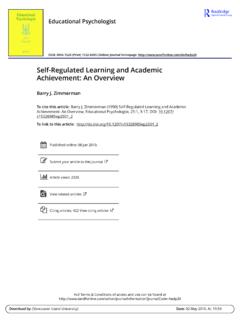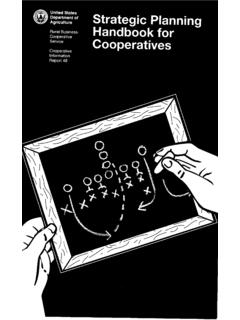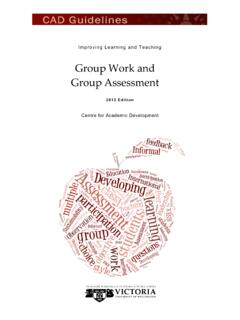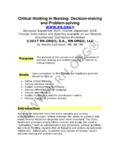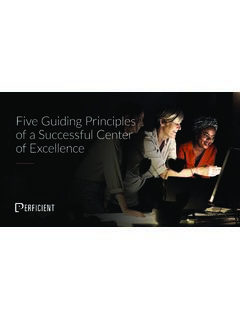Transcription of 7 | Teaching and Learning Strategies
1 VIU Teaching and Learning Handbook7 | Teaching and Learning Strategies Teaching Strategies Choosing a Teaching and Learning strategy is not an easy task. Strategies need to be chosen carefully in order to contribute most effectively to student Learning . Anytime students are actively engaged in Learning , exploring new ideas, and grasping the conceptual nature of the discipline, they are Learning in a deeper and more meaningful way to apply that knowledge and those skills to other parts of their lives. The following information in this section outlines some Strategies that may be used to enhance student Learning . Lecturing: Ten Things to Remember Adapted from Cashin, Effective Lecturing.
2 1. Lecturing is especially useful to convey knowledge, but is not well suited for higher levels of Learning . 2. Decide what you want the students to know and be able to do as a result of the lecture. 3. Outline the lecture notes first your major points, then the minor points that elaborate on or explain each major point. 4. Choose relevant, concrete examples, in advance of the lecture, selecting examples familiar and meaningful to the students. 5. Find out about the students, their backgrounds, and their goals. 6. Permit students to stop you to ask relevant questions, make comments, or ask for review. 7. Intersperse periodic summaries within the lecture. 8. Start with a question, problem, current event, or something that just grabs the students attention.
3 9. Watch the students. If you think they don t understand you, stop and ask them questions. 10. Use active Learning techniques. Use technological aids, such as multimedia presentations. 2 | Teaching and Learning Strategies Strategy Teaching and Learning Strategy Definition and Examples Direct Instruction The Direct instruction strategy is highly teacher-directed and is among the most commonly used. This strategy is effective for providing information or developing step-by-step skills. It also works well for introducing other Teaching methods, or actively involving students in knowledge construction. Possibilities Include: Lecture, Slide Presentation, Explicit Teaching , Drill and Practice, Didactic Questions, Demonstrations, Guided and Shared reading, listening, viewing thinking, Guest Lecture, Video, Multimedia Presentation Interactive Instruction Interactive instruction relies heavily on discussion and sharing among participants.
4 Students can learn from peers and teachers to develop social skills and abilities, to organize their thoughts, and to develop rational arguments. The interactive instruction strategy allows for a range of groupings and interactive methods. It is important for the teacher to outline the topic, the amount of discussion time, the composition and size of the groups, and reporting or sharing techniques. Interactive instruction requires the refinement of observation, listening, interpersonal, and intervention skills and abilities by both teacher and students. Possibilities Include: Debates, Role Playing, Panels, Brainstorming, Peer Partner Learning , Peer Assessment, Discussion, Laboratory Groups, Labs, Think/Pair/Share, Co-operative Learning , Jigsaw, Problem Solving, Tutorials, Interviewing, Conferencing, Team-Based Learning , Seminars Indirect Instruction In contrast to the direct instruction strategy, indirect instruction is mainly student-centered, although the two Strategies can complement each other.
5 Indirect instruction seeks a high level of student involvement in observing, investigating, drawing inferences from data, or forming hypotheses. It takes advantage of students' interest and curiosity, often encouraging them to generate alternatives or solve problems. In indirect instruction, the role of the teacher shifts from lecturer/director to that of facilitator, supporter, and resource person. Possibilities Include: Problem Solving, Case Studies, Reading, Inquiry, Reflective Discussion, Writing, Concept Formation, Concept Mapping, Tutorials Independent Study Independent study refers to the range of instructional methods which are purposefully provided to foster the development of individual student initiative, self-reliance, and self-improvement.
6 While independent study may be initiated by student or teacher, the focus here will be on planned independent study by students under the guidance or supervision of a classroom teacher. In addition, independent study can include Learning in partnership with another individual or as part of a small group. Possibilities Include: Essays, Computer Aided Instruction, Journals, Learning Logs, Reports, Learning Contracts, Homework, Research Projects, Assigned Questions, Learning Centres, Independent Project/Course, Self-Assessment Experiential Learning Experiential Learning is inductive, learner centered, and activity oriented. Personalized reflection about an experience and the formulation of plans to apply Learning to other contexts are critical factors in effective experiential Learning .
7 The emphasis in experiential Learning is on the process of Learning and not on the product. Possibilities Include: Field Trips, Narratives, Conducting Experiments, Simulations, Games, Storytelling, Field Observations, Role-Playing, Model Building, Surveys, Studio Labs, Community Engaged Learning , Study Abroad, Community Service Learning , Undergraduate Research, Internships, Practicum, Co-op Placement, Apprenticeship, Field Courses VIU Teaching and Learning HandbookTeaching For Improved Student Metacognitive Learning Photo Credit: Krissy Venosdale Metacognition: Purposefully thinking about one s own thinking Strategies when students are able to learn to think and think to learn Three critical steps to Teaching metacognition 1.
8 Teaching students that their ability to learn is mutable 2. Teaching planning and goal-setting 3. Giving students ample opportunities to practice monitoring their Learning and adapting as necessary [I]t is terribly important that in explicit and concerted ways we make students aware of themselves as learners. We must regularly ask, not only What are you Learning ? but How are you Learning ? We must confront them with the effectiveness (more often ineffectiveness) of their approaches. We must offer alternatives and then challenge students to test the efficacy of those approaches. (Weimer, 2012) Tips for Fostering Metacognition 1. Formative Assessment: Classroom assessment techniques that are short, reflective and provide feedback on Learning , The Muddiest Point Giving students practice in identifying confusions: What was most confusing to me about the material explored in class today?
9 2. Visual Representation of Course/Class: Diagram, flowchart, concept map of core concepts 4 | Teaching and Learning Strategies 3. Employ Active Reading: Guiding questions for readings, test on key concepts next day or via online quiz, have students teach each other what read, focus attention on solving a problem 4. Teach in Multiple Ways with Choice :Offer Learning experiences that tap into a variety of modes of Learning we all learn through multi-modal ways and need to experience a variety (choice is good too) ways of coming at Learning of a new topic 5. Exam or Lecture Wrappers: Questions, surveys or discussions after Learning /tests/activities have taken place that focus on the Learning and not the event , take up a test as to how students studied, prepared, took the test, hardest questions, easiest questions 6.
10 Self-Assessments: Prior knowledge of performance on a task do pre + post! 7. Reflective Writing Activities: On in class activities, readings, videos, class presentations , most important point learned from reading, most valued Learning and integrating reflection into course work: integrate short reflections (oral or written) that ask students what they found challenging or what questions arose during an assignment/exam/project 8. In Class Feedback on Learning : Best way to support Learning = provide immediate feedback , clickers/polling, minute papers, ticket out door, surveys, group discussions on Learning 9. Students Creating Questions: Have students design possible test or exam questions on readings, content, lessons but also supply the answers.

